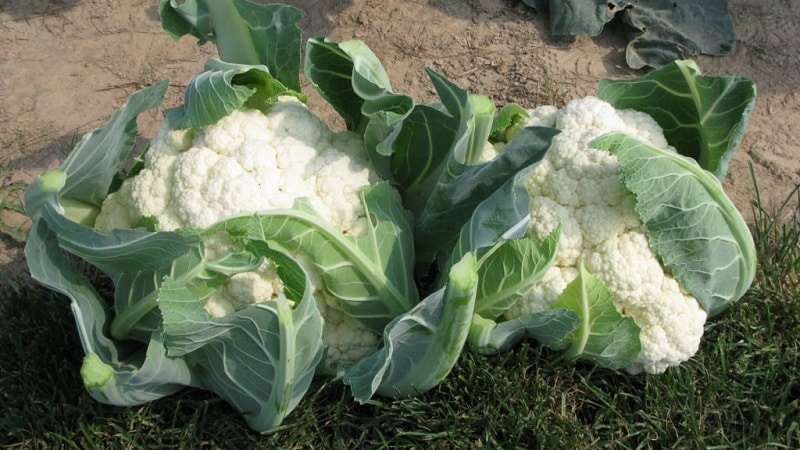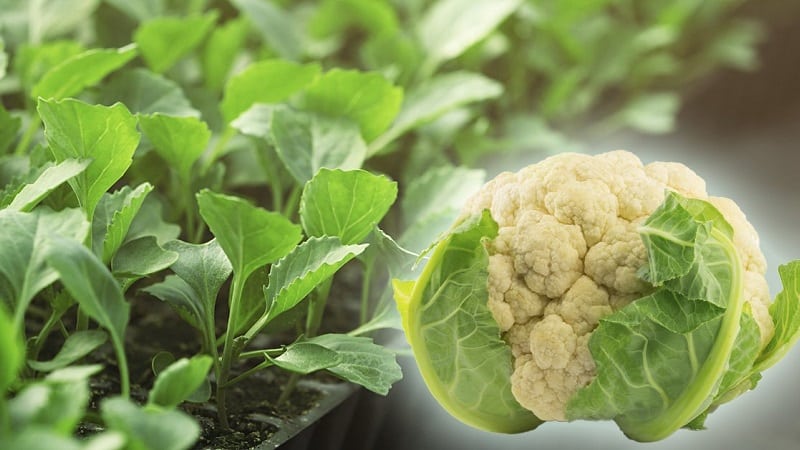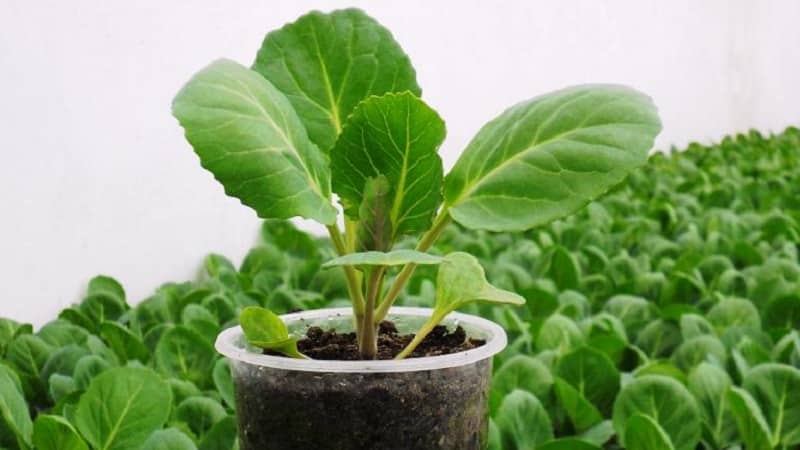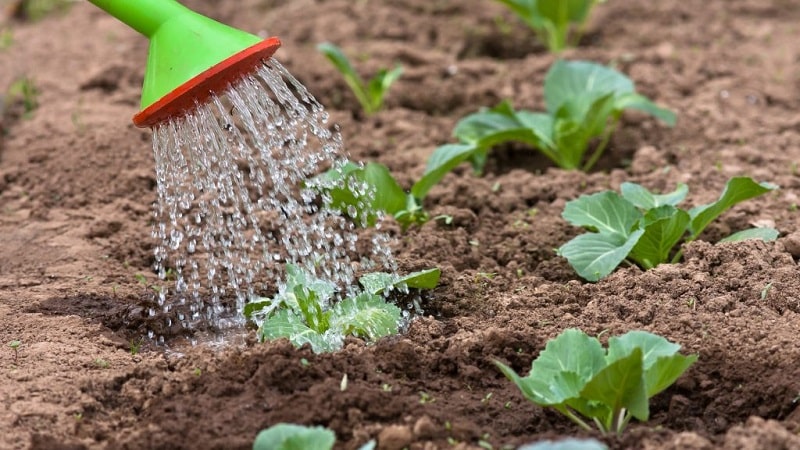Growing and caring for cauliflower in open ground
Cauliflower is one of the most nutritious and healthy subspecies of cabbage. It contains much more vitamins and minerals than cabbage. Many gardeners do not know that in order to obtain a rich harvest of cauliflower, it is important to care for it somewhat differently than for related crops. What cauliflower looks like in the photo, what it means to grow and care for it in open ground - more on all this below.
Growing cauliflower from seeds in open ground
Cauliflower There are different varieties, which are divided into early-ripening, mid-ripening and late-ripening. If you plan not only to eat a vegetable in the summer, but also to store the crop, several plants are planted at once. Planting rules for each variety are individual.

Variety selection and seed preparation
There are many varieties of cauliflower. To choose the right one for yourself, it is better to use the recommendations of experienced gardeners.
The most popular varieties and hybrids include:
- early ripening - Dacha, Malima F1, Movir-74 and 2009, Koza-dereza;
- mid-season - Snow Globe, Flora Blanca, Yarik F1, Lilac Ball;
- late - Cortez F1, Green Snowdrift, Kartier F1.
Interesting things on the site:
Cauliflower does not set in open ground: what to do
Cauliflower has bloomed: what to do with it and can it be eaten
Preparation of seed material occurs in several stages:
 Suitability check. The seeds are poured into a jar or glass, filled with water and mixed. Floating specimens are thrown away because they are empty; those who have sunk to the bottom are used.
Suitability check. The seeds are poured into a jar or glass, filled with water and mixed. Floating specimens are thrown away because they are empty; those who have sunk to the bottom are used.- Heat treatment - a prerequisite for preventing the occurrence of diseases in seedlings and protecting against bolting. This is done in two ways. In the first, the seeds are poured with water (no more than +50°C) and left for about 15 minutes; in the second, they are poured into a sieve and poured over with boiling water, then immediately doused with cold water.
- Germination. To do this, the seeds are soaked for 24 hours in a mineral mixture (for example, in a Fitosporin solution) or warm water without additives.
- Hardening. The dried seeds are placed in the refrigerator for 1 day. This procedure is carried out to protect future plants from diseases and increase their stress resistance to temperature changes.
Only after passing through all stages will the seed material be completely ready for planting. In regions with cold climates, cauliflower is grown only by seedlings. In the southern regions of Russia and Ukraine, seeds are planted immediately in a permanent place. This is done already in mid-April, when the temperature does not drop below +2°C.
Site selection and soil preparation
In order for cauliflower seedlings to take root well, it is important to choose the right place for planting them. This vegetable loves sunlight very much, so it is planted in a well-lit area, avoiding the proximity of tall plants.
Important! Soil acidity levels should be in the range of 6.7–7.4 pH, since cauliflower does not like very acidic soil.
Do not plant crops after:
- radishes;
- radish;
- tomatoes;
- beets;
- other types of cabbage.
Optimal predecessors for this vegetable:
- legumes;
- cereals;
- green manure;
- garlic;
- onion;
- potato;
- carrot.

An important point before planting seedlings in open ground is its preparation.. The ridge is dug up well, plunging the shovel onto a full bayonet.
Nutrients are added to each hole to help the plant take root faster. and protect him from diseases. To do this, use the following mixture:
- a bucket of humus or compost;
- 1 tsp. urea;
- 2 tbsp. ash;
- 2 tbsp. l. superphosphate.
The additive is thoroughly mixed with the soil in the hole. Seedlings are planted in the soil prepared in this way.
Take note:
The best ways to preserve cauliflower for the winter
Delicious recipes for cauliflower salad for the winter in jars
When to sow
The timing of planting in open ground directly depends on the variety of cauliflower.. Early ripening is planted from April 25 to May 15, mid ripening - from May 20 to June 15. Late varieties are transferred to open ground depending on the time of sowing for seedlings. This is usually done after 30 days.
Important! To strengthen the plants, they are fed with mineral fertilizers 2 weeks before planting in open ground. Seedlings must be hardened off in order to gradually accustom them to new conditions.
When transferring seedlings to open ground, they also take into account weather conditions.: the air should warm up to +8…+10°C.
Sowing algorithm
The correct arrangement of seedlings on the ridge will help to obtain A rich harvest of cauliflower will protect it from disease.

The distance between holes is individual for each variety, but there are general rules that it is advisable to follow. The distance between rows is at least 0.5 m, between holes - 35 cm.
In the first days after planting, the plants are covered with non-woven fabric. or plastic film.This will protect them from the cruciferous flea beetle and possible frosts. Remove the covering material after the seedlings have become stronger.
Caring for cauliflower in open ground
The quality and quantity of the harvest directly depend on growing and caring for cauliflower in open ground. It must be watered, weeded, loosened, fertilized, and treated against diseases and pests.
Watering
Cauliflower, like other subspecies of crops, requires regular and even watering. First of all, they focus on weather conditions.
Advice! To prevent the vegetable heads from darkening and burning in the sun, they are covered. To do this, the leaves are slightly broken and tilted towards the middle.
In cloudy and rainy weather, there is no need to additionally moisten the plantings.. During the dry season, water the vegetable approximately once a week. At first, the water consumption will be 6–8 liters per 1 m²; as it grows, the amount of liquid is increased to 10 liters per 1 m².

Top dressing
Fertilize cauliflower with organic and mineral compounds:
- mullein solution: take 0.5 liters of pre-prepared concentrate for 10 liters of water, pour 500 ml of the product under each bush;
- nitrophoska: dilute 2 tbsp in 10 liters of water. l. of the drug, water the ridge at the rate of 6–8 liters per 1 m²;
- solution of mullein and “Kristalin”: dissolve 1 tbsp in 10 liters of organic fertilizer. l. preparation, pour 1 liter of mixture under 1 bush.
In total, cauliflower is fed 3-4 times during the growing season.. The time interval between applying fertilizers should be at least 14 days.
Prevention of diseases and pests
Cauliflower is very sensitive to various diseases and pest attacks., so it is periodically treated with special preparations. If the lesions are not severe, use folk remedies:
- Sprinkling with wood ash or tobacco will protect plants from almost all pests, including slugs.
- Spraying tomato tops, onion peels or burdock with the infusion will protect against cruciferous flea beetles.
- The mustard solution will protect against infestation by caterpillars. To do this, dilute 200 g of powder in 10 liters of warm water, let the solution brew and carefully spray each seedling.
For disease resistance Cauliflower is treated with Symbiont-Universal solution. For 1 m² you will need 400 ml of the finished product. General immunity is also increased by such drugs as sodium humate and Immunocytophyte.
Treatment of cauliflower against pests and diseases is carried out in dry, windless weather.. It is advisable to do this after evening watering.
Conclusion
Choosing the right variety or hybrid, preparing seeds, obtaining high-quality seedlings in the northern regions, following recommendations for planting and caring for cauliflower is the key to obtaining a rich harvest. Timely watering, fertilizing, treatment against diseases and pests will strengthen the plants and protect them from death.